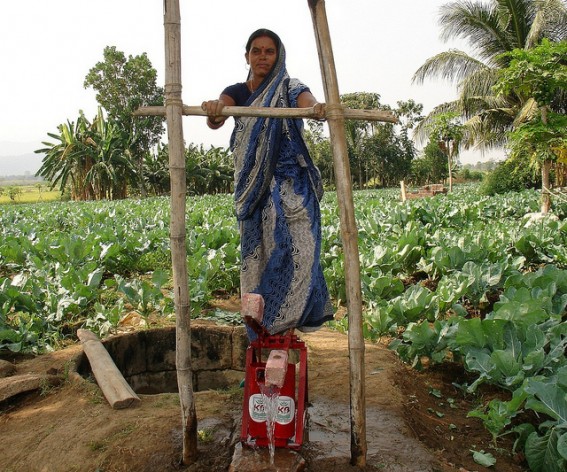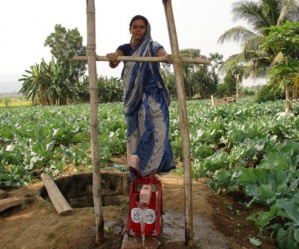Dailycsr.com – 16 July 2015 – A senior scientists of “Indian National Science Academy”, Professor Bijay Singh, who works at the department of “Soil Science” in the “Punjab Agricultural University”, expresses his opinions about the “Green Revolution” of India.
Mr. Singh remarks that for a long time there is a slowing down of agricultural growth rate in India, whereby in the years 1970’s through the following decades to the 80’s, with the introduction of technology, Indian agricultural lands increased their productivity. However, at present the same results seen during the time of “Green Revolution” as mentioned above are not being yielded by the same lands anymore. In fact, currently India is carrying the burden of world’s “second highest number of undernourished people”.
Consequently, the Indian Prime Minister, Narendra Modi, has announced an appeal for a “Second Green Revolution on Indian soil”. Nevertheless, there are complex agricultural problems that stand as a barrier on the way to this Second Green Revolution. Forty years ago, when the first Green Revolution took place, India produced “high yielding varieties of rice and wheat” with the help of improved pesticides, irrigation systems and the use of advanced fertilisers. However, given the present scenario, the prominent trend of climate change combined with “mismanagement of agricultural inputs” have altered the face of “agricultural landscape”, whereby the “Second Green Revolution” urged by the Prime Minister will be to involve refreshed solutions capable of matching the recently faced complexities.
Professor Singh believes that a “data driven approach” is going to be the saviour of the hour. After all the farmers need to be educated with the “information” required to “protect their harvest” amid water scarcity and “soil degradation”. Therefore, various sophisticated technologies like “GreenSeeker optical sensor” and “Leaf Colour Chart”, have been developed to prepare the farmers to meet any odds. In fact, in some of the states of India, like Punjab and Haryana, farmers are already detecting their crop’s health and analysing what would be the right “amount of nitrogen” required in the soil in order to “boost production of cereals like rice and wheat”.
Soil health has been a subject of great consideration in this new venture, whereby in order to arrive at an “optimal soil health” “smart” approach towards creating fertilizers will be given priority as oppose to the long favoured urea “by government subsidy programmes”. Scientists have ended the conflict between the uses of organic versus mineral fertilisers, by demonstrating that both are, in fact, complementary to each other. The role of the mineral fertiliser is to enhance “soil organic matter content” resulting in a “greater root growth” along with “enhanced microbial activity”, whereby the effects of combined use of organic and mineral fertilisers seem “even greater”.
Besides, investing on technologies to improve agricultural production, rural infrastructures needs to be equally developed whereby providing improved access facility to the market. Training sessions needs to be incorporated in order to teach the farmers how to handle the new instruments. Furthermore, the farmers need help to improve their “social standing” through “co-operatives and savings groups”. Following in the footsteps of the “unprecedented” first “Green Revolution”, the second one also need to have equal weight, so as to intervene the “complexities of the 21st century”. If the Second Green Revolution of India comes to fruition, the country will prove to be a pioneer in the said field for the entire world.
References:
http://www.ipsnews.net/2015/07/opinion-what-will-it-take-to-bring-a-second-green-revolution-to-india/
Mr. Singh remarks that for a long time there is a slowing down of agricultural growth rate in India, whereby in the years 1970’s through the following decades to the 80’s, with the introduction of technology, Indian agricultural lands increased their productivity. However, at present the same results seen during the time of “Green Revolution” as mentioned above are not being yielded by the same lands anymore. In fact, currently India is carrying the burden of world’s “second highest number of undernourished people”.
Consequently, the Indian Prime Minister, Narendra Modi, has announced an appeal for a “Second Green Revolution on Indian soil”. Nevertheless, there are complex agricultural problems that stand as a barrier on the way to this Second Green Revolution. Forty years ago, when the first Green Revolution took place, India produced “high yielding varieties of rice and wheat” with the help of improved pesticides, irrigation systems and the use of advanced fertilisers. However, given the present scenario, the prominent trend of climate change combined with “mismanagement of agricultural inputs” have altered the face of “agricultural landscape”, whereby the “Second Green Revolution” urged by the Prime Minister will be to involve refreshed solutions capable of matching the recently faced complexities.
Professor Singh believes that a “data driven approach” is going to be the saviour of the hour. After all the farmers need to be educated with the “information” required to “protect their harvest” amid water scarcity and “soil degradation”. Therefore, various sophisticated technologies like “GreenSeeker optical sensor” and “Leaf Colour Chart”, have been developed to prepare the farmers to meet any odds. In fact, in some of the states of India, like Punjab and Haryana, farmers are already detecting their crop’s health and analysing what would be the right “amount of nitrogen” required in the soil in order to “boost production of cereals like rice and wheat”.
Soil health has been a subject of great consideration in this new venture, whereby in order to arrive at an “optimal soil health” “smart” approach towards creating fertilizers will be given priority as oppose to the long favoured urea “by government subsidy programmes”. Scientists have ended the conflict between the uses of organic versus mineral fertilisers, by demonstrating that both are, in fact, complementary to each other. The role of the mineral fertiliser is to enhance “soil organic matter content” resulting in a “greater root growth” along with “enhanced microbial activity”, whereby the effects of combined use of organic and mineral fertilisers seem “even greater”.
Besides, investing on technologies to improve agricultural production, rural infrastructures needs to be equally developed whereby providing improved access facility to the market. Training sessions needs to be incorporated in order to teach the farmers how to handle the new instruments. Furthermore, the farmers need help to improve their “social standing” through “co-operatives and savings groups”. Following in the footsteps of the “unprecedented” first “Green Revolution”, the second one also need to have equal weight, so as to intervene the “complexities of the 21st century”. If the Second Green Revolution of India comes to fruition, the country will prove to be a pioneer in the said field for the entire world.
References:
http://www.ipsnews.net/2015/07/opinion-what-will-it-take-to-bring-a-second-green-revolution-to-india/


 Professor Bijay Singh On Second Green Revolution Knocking At India’s Doorstep
Professor Bijay Singh On Second Green Revolution Knocking At India’s Doorstep





 Companies
Companies